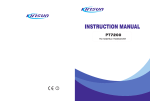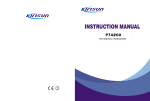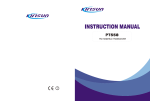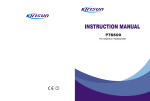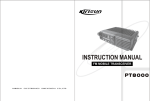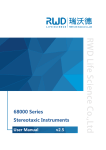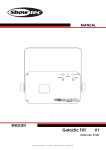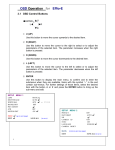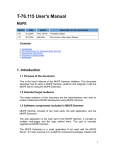Download PT578 User Manual
Transcript
PT578 FM HANDHELD TRANSCEIVER INSTRUCTION MANUAL INSTRUCTION MANUAL PT578 FM HANDHELD TRANSCEIVER We are very grateful for your purchasing brand two-way radios produced by Shenzhen Kirisun Electronics Co., Ltd. We believe two-way radio, which always incorporates the latest technology, can bring great convenience to your life and work; We also believe that the quality and function of meet your demands for reliable communication. two-way radio can Notice to the User: * Government laws prohibit radio communication without permission in areas dominated by the government. * Illegal operation is subject to punishment by fine and/or imprisonment. * Refer service to the well-trained professional technicians only. Safety It is important that user is aware of and understands hazards common to the operation of any radios. Warning! Turn off your radio before entering any area with a potentially explosive atmosphere (where the air contains gas, dust and smog, etc.), such as while taking on fuel, or while parking at a gasoline service station. Precautions in Use Please comply with the following attentions to avoid fire, bodily injury and damage to the radio. * The radio is recommended to transmit for 1 minute and receive for 4 minutes. Long time transmitting or continuous working in high power mode will make the rear side of the radio generate heat. * Please do not disassemble or assemble the radio under any circumstances. * Please do not expose the radio to direct sunlight for a long time; do not place the radio near any heating devices, either. * Please do not put the radio in extremely dusty, moist or dabbling places; do not place it on any unstable surface, either. * If the radio emits smoke or strange odors, turn it off and remove the battery from the radio and contact your local authorized Kirisun dealer without delay. Content 1. Unpacking and Checking......................................1 1. Unpacking and Checking 2.1 Charging the Battery Unpack the radio carefully. We recommend that 2. Preparation...........................................................2 you check the radio and the supplied accessories 2.1 Charging the Battery........................................2 listed in the following table before discarding the 2.2 Installing/Removing the Battery.......................4 packing material. If any damage or loss has occurred 2.3 Installing the Antenna......................................5 during shipment, please contact the dealer without 2.4 Installing the External Speaker/Microphone....5 2. Preparation Plug the adapter into an Antenna Power Adapter 4. Basic Operation...................................................6 5. Functions of Programmable Buttons....................8 6. Auxiliary Functions.............................................10 7. Wired Clone Mode.............................................14 8. Troubleshooting..................................................15 9. Specifications.....................................................16 10. FCC Notice......................................................17 1 connect the power adapter to the battery charger. The delay. green LED will light up. Supplied Accessories Place the battery or radio 2.5 Installing the Belt Clip......................................5 3. Radio Overview....................................................5 applicable AC outlet and into the charger slot, and Item Quantity make sure the radio has Charger been turned off. Antenna 1 Battery 1 Belt Clip 1 Charger 1 light up, and the green LED Power Adapter 1 will be out, which indicates Hand Strap 1 Instruction Manual 1 Battery Make sure the battery is well connected with the charger. Then the red LED will Belt Clip Hand Strap that the charging starts. 2 After about 3~4 hours of charging, the red LED will * Do not recharge the battery if it has been fully charged be out, and the green LED will light up, which or the radio is not in the low battery alarm state; otherwise, indicates that the battery is fully charged, then you it will have bad effects on the battery's service life and can remove the battery from the charger. performance. Remove the battery from the charger The charger will enter the protection mode if the after charging. temperature or the circuit is abnormal, and the LED * When the radio is in the low battery alarm state, please will flash yellow. Do not charge the battery by force at recharge the battery before use. Do not turn the radio this moment, just remove the battery and cut off the power on by force; otherwise, it will have bad effects power of the charger. on its service life and performance. 2.2 Installing/Removing the Battery Installing the Battery: Match the two bulges at the upper end of the battery with the corresponding grooves on the top of the radio and insert the battery. Removing the Battery: To remove the battery pack, push the release latch in the bottom of the radio forwards, the battery will bounce up automatically. Then loose the belt clip slightly and remove the battery pack away from the radio. Note: * The radio battery is not fully charged in the factory. Before the initial use, please charge the new battery. * KB-56B Li-poly battery of the company is applicable to this radio. * When charging the battery for the first time after purchase Firmly press or long-time storage (over 2 months), please repeat the battery pack charging several times for the battery to achieve normal downwards until capacity. Meanwhile, please make sure the battery is the battery latch charged at least once every three months. 3 locks. Note: * Do not short-circuit the battery terminals or dispose battery in fire. * Do not disassemble the battery casing by yourself. 4 A. LED Indicator 2.3 Installing the Antenna 2.5 Installing the Belt Clip Hold the bottom of the Match the two holes of the Lights red while transmitting; lights green while antenna and turn the antenna belt clip with those on the rear receiving; flashes red when the radio is in low External speaker/microphone can be connected to clockwise into the connector of the radio, and then fix the power. the radio through this jack. B. On/Off/Volume Control Knob on the top of the radio until belt clip to the radio with two secure. 2.5x8.0 screws. Loose the Turn clockwise until you hear a click to turn the fixing screws to remove the radio power on. Turn counterclockwise until you belt clip. hear a click to turn it off. 3. Radio Overview I. Microphone J. External Speaker/Microphone Jack 4. Basic Operation 4.1. Switch On Switch on the radio by turning the On/Off/Volume Rotate it to adjust the volume after turning on the control knob clockwise until a click is heard. If radio. programmed, a beep tone will be heard. C. Channel Selector Knob Rotate to select channel 1-16. 2.4 Installing the External Speaker/Microphone Open the cover for external speaker/microphone jack, and then insert the external speaker/microphone plug into the jack on the radio. 5 D. Antenna E. Top Button (programmable button) F. PTT (Push-To-Talk) Button Press and hold the PTT button and speak into the microphone, your voice can be sent to the recipient. Release the PTT button to receive. G. Side Button 1 (programmable button) H. Side Button 2 (programmable button) 6 4.2 Adjust Volume 4.4 Make a Call 5. Functions of Programmable Buttons Press the preprogrammed To make a call, select “Squelch Off ” button to hear the desired channel, background noise. Then press and hold the PTT The dealer can assign one of the following rotate the On/Off/Volume button, and speak to the auxiliary functions to the top button, side button 1 or control knob to adjust the microphone in normal side button 2. volume. voice. Please keep your mouth 5-10cm away from the microphone. No. Function 3 Lone Worker Press the preprogrammed Rotate the channel selector 4.5 Receive a Call Press the preprogrammed “Emergency Alarm” button to No. 0 1 Release the PTT button to receive a call. knob to select the required Your dealer can set CTCSS/DCS signaling on your channel. You will hear voice radio channels by PC software. If you select a from the speaker while channel that has been preset with the signaling, you receiving valid signals. will not hear other calls except those from your own system. Function None Description No function is assigned. Voice Emergency 4 Annunciation Alarm your ID or background sound to your partner or the system. mode of voice annunciation, number can be heard. Press the preprogrammed 5 When the preprogrammed Emergency “Emergency Alarm Off ” button Alarm Off to quit the Emergency Alarm Mode. “Talkaround” button is pressed, Talkaround to the s e t t i n g of the programming software or send “Voice Annunciation” button to meanwhile, the current channel 2 make an alarm tone according change the language and the next transmission will be at Press the preprogrammed the same frequency as at “Scan” button to start/stop which it is received. 7 “Lone Worker” button to start/stop lone working. Press the preprogrammed 4.3 Select a Channel Description 6 Scan scanning. 8 No. Function Description No. Function you can receive signals that If the radio stays at a noise 7 Nuisance channel while scanning, press Delete the preprogrammed “Nuisance (temporary) 10 Monitor 9 b) After the pre-alert tone, the timer will action 6.1 TOT (Time-Out-Timer) when the transmitting time has gone beyond the limit. 1) TOT Function 4) TOT Reset Time Delete” button to delete the resume normal operation. a) The time delay from releasing the PTT button to noise channel temporarily. Press and hold the prepro- continuously talking overlong and occupying one grammed “Momentary Squelch certain channel for an extended period of time, and Momentary prevent the radio from heating due to continuous releasing the PTT key is shorter than the reset time. release it to resume normal 6.2 Battery Saving Power button to switch between high Switch and low transmitting power of operation. the radio. Press the preprogrammed limit. If the radio is continuously transmitting longer Press and hold the prepro- “Squelch Off ” button to open than the time preset by the dealer, the radio will make alarm and stop transmitting. Squelch Off 12 Squelch Off grammed “Momentary Monitor” squelch. Press it again to Momentary button to disable CTCSS, DCS resume operation. Monitor signaling, and release the Press the preprogrammed button to resume normal “Lone Worker Reset” button b) The radio is set with a continuous transmitting 2) TOT Rekey Time a) A period in which the radio is forbidden to transmit after its overtime activity. while the radio is in Lone b) During the period, if the PTT button is pressed, Worker Mode to reset the lone an alert tone will be sounded, and the transmission is “Monitor” button to disable worker timer, and the timer forbidden. CTCSS, DCS signaling, and starts again. 13 Lone Worker Reset b) The countdown will go on if the time after transmitting. “High/Low Power Switch” 11 the resetting of the timer is limited. Off”button to open squelch; High/Low 10 Monitor a) The pre-alert will sound before the TOT action. a) The time-out-timer can prevent the user from operation. Press the preprogrammed 9 cannot be heard under normal 6. Auxiliary Functions operation. Press it again to Press the preprogrammed 8 Description 3) TOT Pre-alert The dealer can set the power saving mode by programming. If this function is enabled, and the radio hasn't receive any signal or no operation is being acted for 10 seconds, the radio will enter Battery Saving Mode. When a signal is received or any operation occurs, it will exit the Battery Saving Mode automatically. There are four types for battery saving: 1:1, 1:2, 1:4 and Off. The automatic battery saving function can reduce power consumption of the radio. 10 6.3 Low Battery Warning When the battery voltage drops too low, the LED transmit will only be received by parties whose CTCSS/DCS tones are the same as yours. these channels. 6.7.1 Starting/Stopping Scan channel, it will stay at the priority channel; if there is no signal, it will return to the original channel. will flash. When the battery voltage drops too low Note: a) Press the button set as “Scan” to start scanning. c) The revert channel (Tx channel) during the scan while transmitting, the LED flashes red and then the * Using a CTCSS/DCS channel doesn't mean your While in scanning, the radio checks every channel in can be designated by the dealer. There are following radio stops transmitting. You need to recharge or calls are private. If other parties' CTCSS/DCS tones the scan list and stops on which a signal is detected options available: change the battery. are identical with yours, they can hear your calls. until that signal disappears. If interval between signal Selected Channel: When pressing the PTT button, 6.4 Voice Annunciation This function can be enabled or disabled by the dealer. There are two languages available: Chinese * Set the battery saving mode to be “O ff ” or “1:1” if disappearing and continuing scanning has been the radio will transmit from the first channel of the the CTCSS/DCS decoding time is long. preset, the radio will remain on that channel. scan list. 6.6 Talkaround and English. After selecting a channel by turning the You can expand the communication range of your channel selector knob, the channel number will be network through a repeater. If the radio is out of the annunciated. communication range, you can connect with other 6.5 CTCSS/DCS radios through “Talkaround” mode. The dealer can set CTCSS/DCS tones on radio channels, which enables you to ignore (not hear) calls from other irrelevant parties who are using the same channel. When you receive a signal that has a tone different from the one set on your radio, you will not hear the signal. Likewise, signals that you 11 Press the preprogrammed “Talkaround” button to switch between “Talkaround” mode and “Repeater” mode. b) Priority Scan: One channel in the scan list can be set as the Selected Channel + Currently Working Channel: When pressing the PTT button during scanning, the priority channel, which enables it to have the highest radio will always transmit from the first channel in the priority during scanning. The radio will scan a non- scan list. When pressing the PTT button during the priority channel firstly, then the priority channel, and scanning pause, the radio will always transmit from then the next non-priority channel, and then the the currently working channel. priority channel again, and the scan goes on like this. If the priority channel and the “lookback time” have Priority Channel: The radio will transmit from the priority channel in the scan list when pressing the been set for the scan list, when the radio is receiving PTT button. signals on a non-priority channel, and the scanning is Priority Channel + Currently Working Channel: In order to receive calls from many different paused, the radio will check the priority channel at the When pressing the PTT button during scanning, the channels, the radio can be programmed to scan preset intervals. If there are signals in the priority radio will always transmit from the priority channel. 6.7 Scan Function 12 When pressing the PTT button during the scanning scan list cannot be deleted. pause, the radio will transmit from the currently button) or any button (if any button is designated as * Quit the scan mode and enter it again, the deleted the lone worker timer reset button) to restart the lone working channel. channel will be added to the scan list again. worker timer. Last Called Channel: When pressing the PTT 6.8 Lone Worker 6.9 Emergency Alarm button, the radio will transmit from the last channel that received a call. Last Used + Currently Working Channel: When pressing the PTT button during the scanning, the radio will transmit from the last channel that transmits signals. When pressing the PTT button during the scanning pause, the radio will transmit from the currently working channel. 6.7.2 Nuisance Delete During scanning, if a channel continually generates unwanted noise or interference, you can press the preprogrammed “Nuisance Delete” button to remove the channel from the scan list temporarily. Note: * The priority channel and the last channel in the 13 If lone worker function is enabled by PC software, Press the preprogrammed “Emergency Alarm” you can press the button set as lone worker to start button (the pressing time should be longer than the lone working. This mode is to ensure the safety of the debounce time of the emergency alarm switch) to user while using the radio separately. The lone enter the Emergency Alarm Mode. You can give the worker timer starts upon pressing the warning tone according to the programming software, preprogrammed “Lone Worker” button. If the preset or send the background sound to your partner or the lone worker time expires, the radio will make an alert system. tone. If the preset remind time expires, the radio will enter Emergency Mode and make alarm. Press the preprogrammed “Emergency Alarm Off ” button to quit the Emergency Alarm Mode, the radio In the Lone Worker Mode, press the prepro- stops the alert and resumes normal operation. grammed “Lone Worker” button again to quit Lone Worker Mode. In the Lone Worker Mode, press the preprogrammed “Lone Worker Reset” button (if a button is designated as the lone worker timer reset The operating steps go as follows: 1. Press and hold side button 2 while turning the radio power on to enter Clone Mode. If the wired clone function is disabled, the radio will enter User Mode. 2. Connect the slave radio with the master radio by a clone cable. Then switch on the slave radio. 3. Press side button 1 of the master radio, the cloning starts. During the data transmission process, the master radio will light red, and the slave radio will light green. When the cloning is finished, the red LED of the master radio will be off, and the slave radio will restart automatically. 4. You can continue to clone data according to step 3. Note: The wired clone function can be enabled or 7. Wired Clone Mode If the wired clone function is enabled by PC software, after entering the Wired Clone Mode, the disabled by the PC programming software. Once the wired clone function is disabled, the radio cannot enter Wired Clone Mode. radio needs to be restart to return to user mode. 14 8. Troubleshooting No. Causes and Solutions Problem squelch level. No. The radio cannot 1 Causes and Solutions Problem be switched on or no display after being switched on. 2 unlocked (Beeping) No signal The transmitting B. The fuse of the power supply is burnt out. Please change it. C. The power switch is in failure. Please change it. 5 red light is on, but D. The battery is out of power, please recharge it or change it. no voice is heard. E. The CPU is broken, please change it. The receiving green B. The crystal oscillator of phase lock loop is broken, please change it. D. The mixer tube is broken, please change it. E. The FM processing IC is broken, please change it. A. The battery and the radio are not reliably connected. Please reinstall the battery. A. The channel frequency setting is out of range, please reset the channel data. Phase lock loop 4 6 light is on, but no voice is heard. A. The power module is broken, so there is no power output. Please change it. B. The microphone is broken, please change it. A. The speaker is broken, please change it. B. The audio amplifier is broken, please change it. C. The oscillating tube is broken, please change it. D. The phase lock loop IC is broken, please change it. A. The frequencies of both users are not the same. Please select the same 3 Cannot transmit 9. Specifications frequency channel again. B. The CTCSS/DCS signals of both users are not the same. Please reset it. General Specification 136-174MHz, VHF C. The radio is out of effective communication range. A. The antenna is in poor contact. Please fasten the antenna head. 4 No signal 15 Frequency 400-450MHz, UHF 420-470MHz. UHF B. The HF amplifier is broken, please change it. C. The squelch level is so high that the squelch cannot be opened. Please reset the PT578 Number of channels 16 16 General Specification Channel spacing Dimension(H×W×D) Weight Operating temperature PT578 25kHz(W)/12.5kHz(N) 250g(including battery and antenna) -25℃ +55℃ ≤ 0.28μV Frequency stability 2.5ppm Max. frequency deviation Max. audio power Power supply Your KIRISUN radio generates RF 114mm×53.5mm×33.5mm Receiving sensitivity Tx power 10. FCC Notice 4W (UHF), 5W(VHF) ±5KHz(W)/±2.5KHz(N) ≥1000mW DC7.4V WARNING DO NOT operate the radio without a proper antenna netic Fields. American National Standards Institute (C95.11992), IEEE Standard for Safety Levels with Respect also cause you to exceed FCC RF exposure limits. electromagnetic energy during to Human Exposure to Radio Frequency A proper antenna is the antenna supplied with this transmit mode. This radio is designed Electromagnetic Fields, 3 kHz to 300 Ghz. radio by the manufacturer or antenna specifically for and classified as “Occupational American National Standards Institute (C95.3- Use Only”, meaning it must be used 1992), IEEE Recommended Practice for the only during the course of employment by individuals Measurement aware of the hazards, and the ways to minimize such Electromagnetic Fields– RF and Microwave. hazards. This radio is NOT intended for use by the “General Population” in an uncontrolled environment. of Potentially Hazardous authorized by the manufacturer for use with this radio. DO NOT transmits for more than 50% of total radio use time (“50%duty cycle”). Transmitting more than The forementioned accessories are authorized for 50% of the time can cause FCC RF exposure use with this product. Use of accessories other than compliance requirements to be exceeded. The radio This radio has been tested and complies with the those (listed in the instruction) specified may result in is transmitting when the “TX indicator” lights red. FCC RF exposure limits for “Occupational Use Only”. RF exposure levels exceeding the FCC requirements You can cause the radio to transmit by pressing the In addition, your KIRISUN radio complies with the for wireless RF exposure. “PTT” switch. following Standards and Guidelines with regard to RF ALWAYS keep the antenna at least 2.5 cm (1 inch) energy and electromagnetic energy levels and evaluation of such levels for exposure to humans: FCC OET Bulletin 65 Edition 97-01 Supplement C, Evaluating Compliance with FCC Guidelines for Human Exposure to Radio Frequency Electromag- 17 attached, as this may damaged the radio and may CAUTION To ensure that your expose to away from the body when transmitting and only use RF electromagnetic energy is the KIRISUN belt-clip which is listed in instructions within the FCC allowable limits for when attaching the radio to your belt, etc., to ensure occupational use, always adhere to FCC RF exposure compliance requirements are not the following guidelines exceeded. To provide the recipients of your 18 transmission the best sound quality, hold the those persons are fully aware of the potential for OPERATING NOTES NEVER short the terminals of the battery pack. antenna at least 5 cm (2 inches) from your mouth, exposure and can exercise control over their When transmitting with a portable radio, hold the NEVER connect the transceiver to a power source and slightly off to one side. exposure. radio in a vertical position with its microphone 5 to 10 other than the Battery listed above. Such a connection IMPORTANT cm (2 to 4 inches) away from your mouth. Keep the will ruin the transceiver. with the information needed to make him or her READ ALL INSTRUCTIONS carefully and antenna at least 2.5 cm (1 inch) from your head and DO NOT push the PTT when not actually desiring to aware of RF exposure, and what to do to assure that completely before using the transceiver body. transmit. this radio operates with the FCC RF exposure limits SAVE THIS INSTRUCTION MANUAL- This If you wear a portable two-way radio on your body, of this radio. instruction manual contains important operating ensure that the antenna is at least 2.5 centimeters (1 sunlight or in areas with temperatures below –30°C Electromagnetic Interference/Compatibility instructions for the Two-Way Radio inch) from your body when transmitting. (–22°F) or above +60°C (+140°F). PRECAUTIONS WARNING! DO NOT modify the transceiver for any reason. NEVER hold the transceiver so that the antenna is MAKE SURE the flexible antenna and battery pack The information listed above provides the user During transmissions, your KIRISUN radio generates RF energy that can possibly cause EXPLICIT DEFINITIONS AVOID using or placing the transceiver in direct very close to, or touching exposed parts of the body, are securely attached to the transceiver, and that the Personal injury,fire hazard or electric especially the face or eyes, while transmitting. The antenna and battery pack are dry before attachment. shock may occur. transceiver will perform best if the microphone is 5 to Exposing the inside of the transceiver to water will Equipment damage may occur. 10 cm (2 to 4 inches) away from the lips and the result in serious damage to the transceiver. If disregarded,inconvenience only.No transceiver is vertical. FCC CAUTION: Changes or modifications to this risk of personal injury,fire or electric WARNING! device, not expressly approved by KIRISUN, could shock. NEVER operate the transceiver with a headset or void your authority to operate this transceiver under is used in situations in which persons are exposed other audio accessories at high volume levels. FCC regulations. as consequence of their employment provided CAUTION! interference with other devices or systems. To avoid such interference, turn off the radio in areas where signs are posted to do so. DO NOT operate the transmitter in areas that are WORD WARNING CAUTION sensitive to electromagnetic radiation such as hospitals, aircraft, and blasting sites. Occupational/Controlled Use The radio transmitter 19 NOTE DEFINITION 20 DECLARATION OF CONFORMITY NOTE: NOTE: NOTE: We, Shenzhen Kirisun Electronics Co., Ltd. 3-6Flrs,ROBETA Building, No. 1, QiMin Road, Song Ping Shan Area, Science & Industry Park,Nanshan District Shenzhen 518057 P.R.China Declare on our sole responsibility that this equipment complies with the essential requirements of the Radio and Telecommunication Terminal Equipment Directive,1999/5/EC,and that any applicable Essential Test Suits measurement have been performed. Description of equipment: FM Handheld Transceiver Model No.: PT578 This compliances is based on conformity with the following harmonised standards or documents: (1). ETSI EN301 489-1 (2). ETSI EN301 489-5 (3). ETSI EN300 086-1 (4). ETSI EN300 086-2 (5). EN60950 Shenzhen, 10 Dec 2008 WenLiang, Fu Place and date of issue General Manager Signature 402-E1300A-RD7A Kirisun Electronics Co., Ltd 11 21 12 22















